March 2025
The global digital freight matching market size is evaluated at USD 62.51 billion in 2025 and is forecasted to hit around USD 766.72 billion by 2034, growing at a CAGR of 32.12% from 2025 to 2034. The North America market size was calculated at USD 14.36 billion in 2024 and is expanding at a double-digit CAGR of 32.14% during the forecast period. The market sizing and forecasts are revenue-based (USD Million/Billion), with 2024 as the base year.
The global digital freight matching market size accounted for USD 47.31 billion in 2024 and is expected to exceed around USD 766.72 billion by 2034, growing at a CAGR of 32.12% from 2025 to 2034. The digital freight matching market growth is attributed to the increasing demand for efficient, real-time freight solutions and advancements in technology that optimize logistics operations.
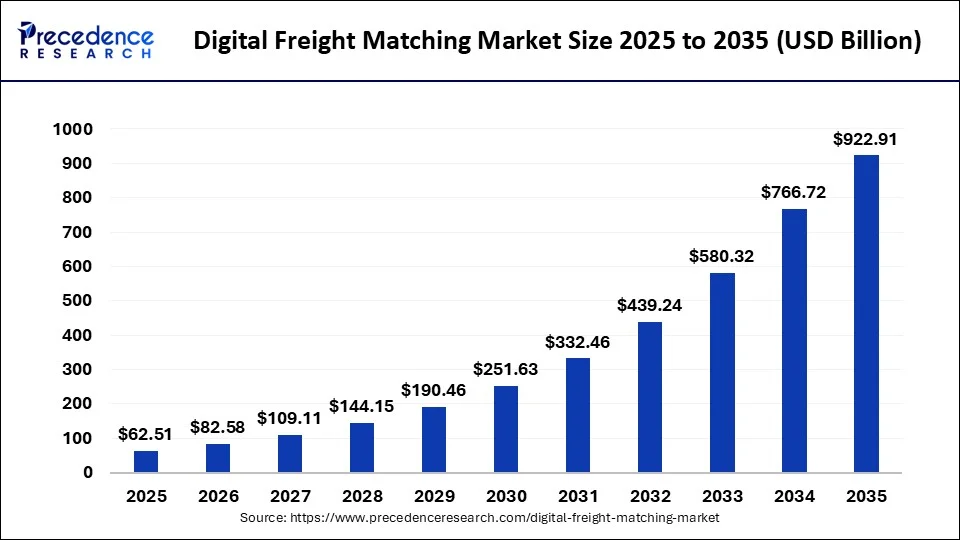
Artificial intelligence enhances an extensive range of improvements within the digital freight matching market by enhancing the speed and accuracy of decisions made. Intelligent devices improve productivity through multiple functions, including matching loads, choosing routes, and anticipating demand. Machine Learning makes it possible for logistics companies to better strategize. Additionally, real-time information handling helps shippers and carriers in timely information exchange, lesser equipment idle time, and optimum use of assets.
The U.S. digital freight matching market size was exhibited at USD 10.48 billion in 2024 and is projected to be worth around USD 171.32 billion by 2034, growing at a notable CAGR of 32.23% from 2025 to 2034
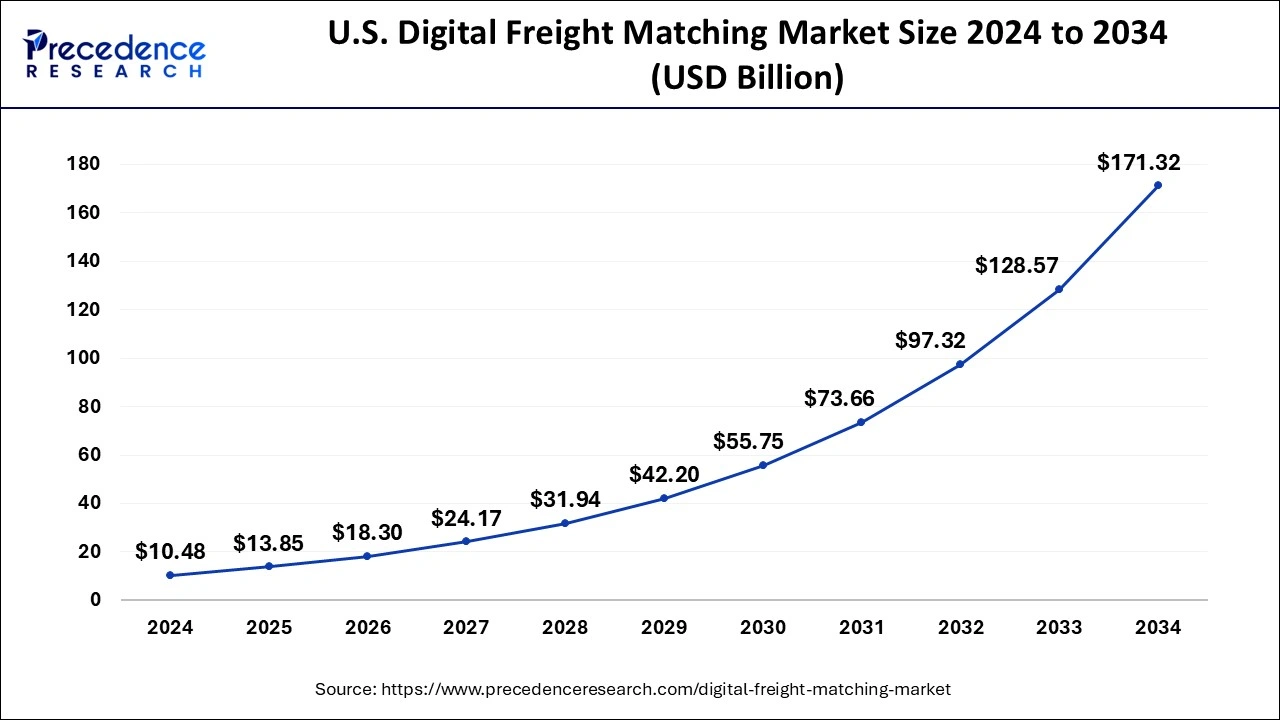
North America dominated the global digital freight matching market in 2024 due to the strong logistics and transport infrastructure and the attractiveness of digital supply solutions as a means of logistics advancement and expense decrease in growth. The increase in the use of e-commerce and other online shopping systems has led to the increase in the need for providers of faster freight delivery services in the United States and Canada, hence the popularity of freight matching platforms. Additionally, improvements in artificial intelligence and the Internet of Things (IoT) are creating better improvements for freight optimization in the region.
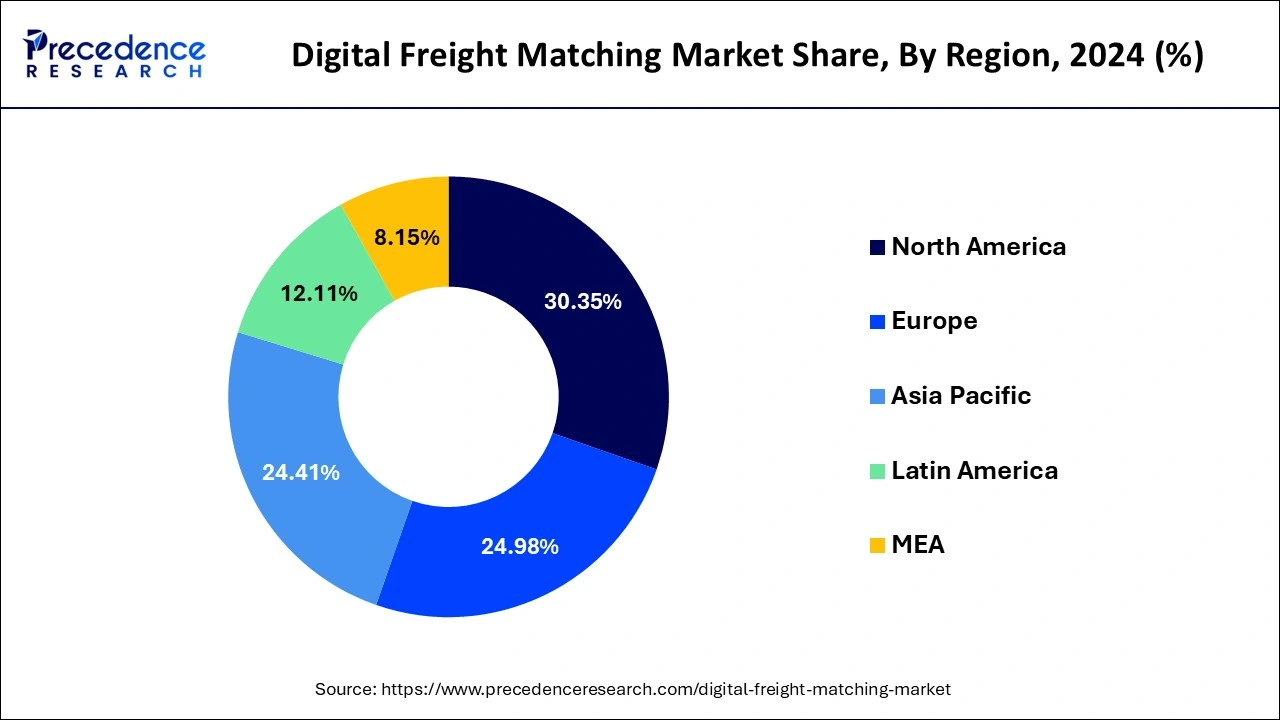
Asia Pacific is projected to host the fastest-growing digital freight matching market in the coming years, owing to the fast-growing e-commerce channels, increasing manufacturing capacity, and a strategic supply-chain hub of the world. India and Japan have been pulling through an increased demand for logistics since more and more goods are being manufactured and consumed. The adoption of digital platforms throughout the region, but especially in China and India, improves the utilization of freight services and objectives optimal routes of transport while reducing its cost. Furthermore, the growing attention to emerging economies like India and SEA facilitates the advance of digital freight-matching technologies.
The digital freight matching market is growing dramatically due to the increasing need for up-to-date information in the supply chain. This demand has been mainly driven by the growth of e-commerce businesses that require fast, dependable, and adaptable freight solutions. Companies now want to find solutions that assist large organizations in bettering the management of the logistical processes within the e-commerce environment to help with duration and expenses. Freight matching solutions draw on the use of modern technologies, such as artificial intelligence, machine learning, and the Internet of Things, in the logistics chain. These technologies allow the identification of vehicles’ location, the determination of the optimal route, and the creation of conclusions and forecasts, making business processes more efficient and decreasing operational expenses.
| Report Coverage | Details |
| Market Size by 2024 | USD 47.31 Billion |
| Market Size in 2025 | USD 62.51 Billion |
| Market Size in 2034 | USD 766.72 Billion |
| Market Growth Rate from 2025 to 2034 | CAGR of 32.12% |
| Dominating Region | North America |
| Fastest Growing Region | Asia Pacific |
| Base Year | 2024 |
| Forecast Period | 2025 to 2034 |
| Segments Covered | Service, Platform, Transportation Mode, Industry, and Regions |
| Regions Covered | North America, Europe, Asia-Pacific, Latin America, and Middle East & Africa |
Growing e-commerce sector
Growing e-commerce activity is projected to contribute significantly to the digital freight matching market expansion. This fast-growing online shopping industry puts pressure on delivery solutions, expecting growth in freight-matching platforms. Distribution channels and stores have merged spending for technology solutions in logistics to cope with the high delivery volume and to meet timely delivery commitments. Better shipper-carrier organization leads to quicker responses to supply chain requirements swings. Furthermore, with growing e-commerce businesses in emerging countries, SMEs have a chance to be a part of these platforms, leading to an increase in the overall use of e-commerce.
Resistance to technological change
Resistance to adopting new technologies among traditional logistics providers is anticipated to restrain the digital freight matching market growth. A large number of small and family-run freight companies still use traditional techniques since they are not aware of technologies. They lack adequate technological knowledge and skills, and they are also most likely to develop operational hitches during the conversion process. Furthermore, established management teams are inclined to achieve cost efficiencies at the expense of investment in new digital platforms.
Increasing preference for real-time freight visibility
Increasing preference for real-time freight visibility is anticipated to create immense opportunities for the digital freight matching market. The supply chain is under pressure to be more transparent from the business perspective for better ordering and effective planning. These needs are met by the digital platform, which has the tools for monitoring in real-time to reduce the aspects of insecurity in freight management. Increased pressures in customer satisfaction and supply chain vulnerability make the improvement of real-time freight tracking systems possible. Furthermore, this trend points to the need for real-time visibility solutions to improve optimal operational performance and satisfy customers' needs in the course of a fast-evolving economy.
The freight matching services segment held a dominant presence in the digital freight matching market in 2024 due to its ability to optimize the allocation of shipments, reduce empty miles, and increase the overall efficiency of freight operations. The pressure on shippers and carriers to cut delivery costs and reduce transportation time results in the increased usage of freight-matching services. Such services enable real-time data sharing, route optimization, automated load matching, and faster delivery of products and services with lower operational expenses. Additionally, these technologies help predict demand patterns.
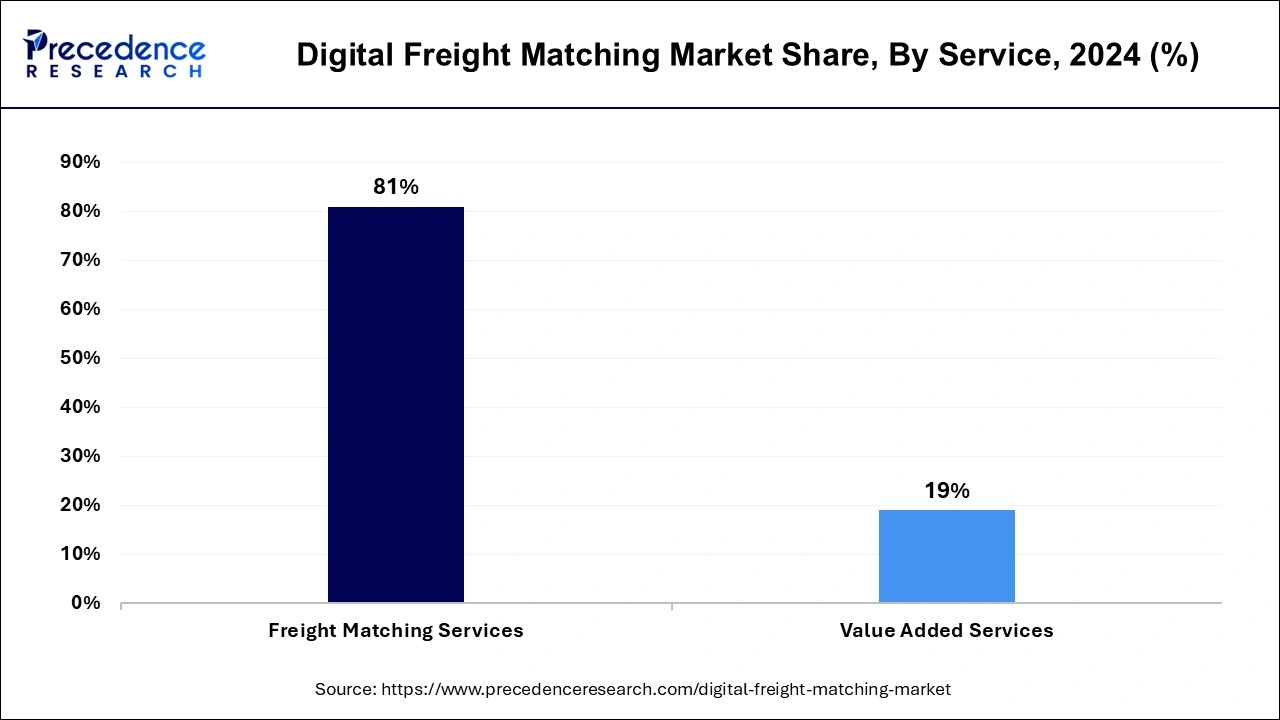
The value-added services segment is expected to grow at the fastest rate in the digital freight matching market during the forecast period of 2025 to 2034, owing to the growing thrust of organizations to enhance shipment visibility throughout the supply chain. The higher need for customer satisfaction is expected to push the adoption of value-added services because of the increasing complexity of the supply chain. These services were expected to help shippers increase supply chain security, adherence to the set laws and regulations, and control of disruption in the network.
The web-based segment accounted for a considerable share of the digital freight matching market in 2024 due to the growing reliance on centralized, accessible digital solutions in logistics operations. These websites provide a full package of tools containing tracking in real-time, freight matching, and optimization of routes with the help of permanent access to them from the computer. The flexibility in flexibility that comes with using website interfaces on different gadgets and the integration and enterprise-wide control that come with web applications. They have made web-based platforms a go-to for logistics service providers and shippers.
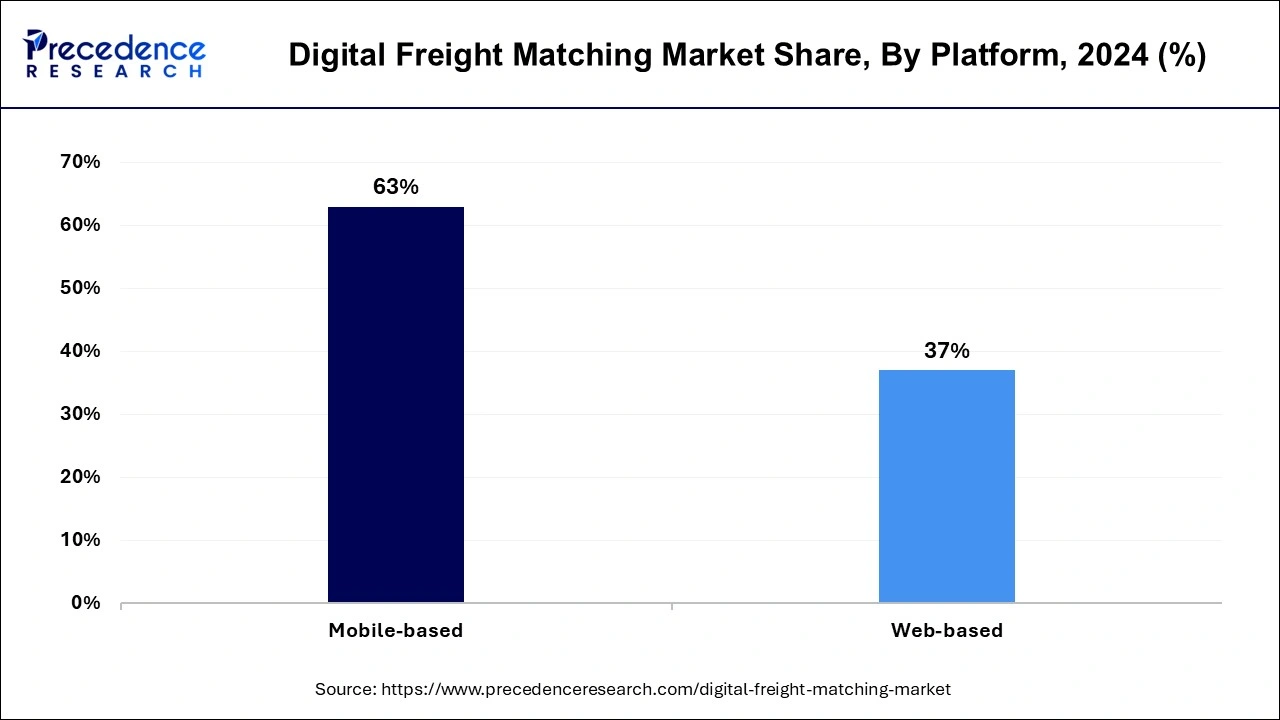
The mobile-based segment is anticipated to grow with the highest CAGR in the digital freight matching market during the studied years, owing to the increasing reliance on mobile technology and the need for on-the-go access to freight management solutions. These platforms are used to schedule deliveries, monitor freight in real-time, and interact with carriers and shippers from your smartphone or tablet. Mobile workforce management and the change of logistics practices toward being more flexible and adaptable are going to help the growth of mobile-based platforms. Additionally, higher mobility with instant booking and freight tracking has made mobile-based solutions quite appealing to small businesses and independent carriers.
In 2024, the full truckload segment led the global digital freight matching market due to the increasing demand for large shipments and the ability to maximize truck capacity, reducing costs per unit. FTL services are usually chosen by shippers in cases where they have big volumes of shipment and need direct routes from the source to the door without having to pass through other locations. The financial predictions about the further development of e-commerce and industry, where a full truckload is needed for the transportation of products, promote the staying of FTL.
The less-than-truckload segment is projected to expand rapidly in the digital freight matching market in the coming years, owing to the increasing demand for flexible and cost-effective shipping solutions. Small and medium-sized enterprises are expected to be a driving force to this growth, as they look for cheaper ways of moving consignments of goods. The benefit of LTL is cutting costs by sharing the expenses of transport with other consignees who have similar, smaller volumes. LTL services facilitate digital freight matching, helping to find the best routes and capacities for providing services.
The food and beverage segment dominated the global digital freight matching market in 2024 due to the growing need for fast, efficient, and also temperature-sensitive logistic services. The global population also continues to increase together with its demand for convenient delivery, contributing to the need for improvements in the logistic systems of this industry.
Industry challenges that pressure manufacturers of food and beverages include variations in demand, the perishable nature of the products, and a strict legal regime emanating from transportation guidelines. There are fairly evident common issues when it comes to freight matching, and having digital freight matching platforms address this problem and offer real-time visibility and optimal routes whereby overcoming these problems is achievable with ease. Furthermore, as the e-commerce function continues to grow, the implementation of these solutions is expected to increase.
The retail and e-commerce segment is projected to grow at the fastest rate in the digital freight matching market in the future years, owing to the massive shift towards online shopping and the increasing demand for faster deliveries. The primary dependency of this sector depends on the freight providers to manage large numbers of small shipments, which should arrive at the customers’ places as soon as possible. The increased demand for same-day or now next-day delivery is likely to force retailers and logistics service providers to spend on conventional freight-matching service solutions that increase efficiencies and cut costs. Furthermore, with improved technological approaches in supply chain management, e-commerce facilities have gradually incorporated advanced freight-matching technologies that are forecast to record steep growth.
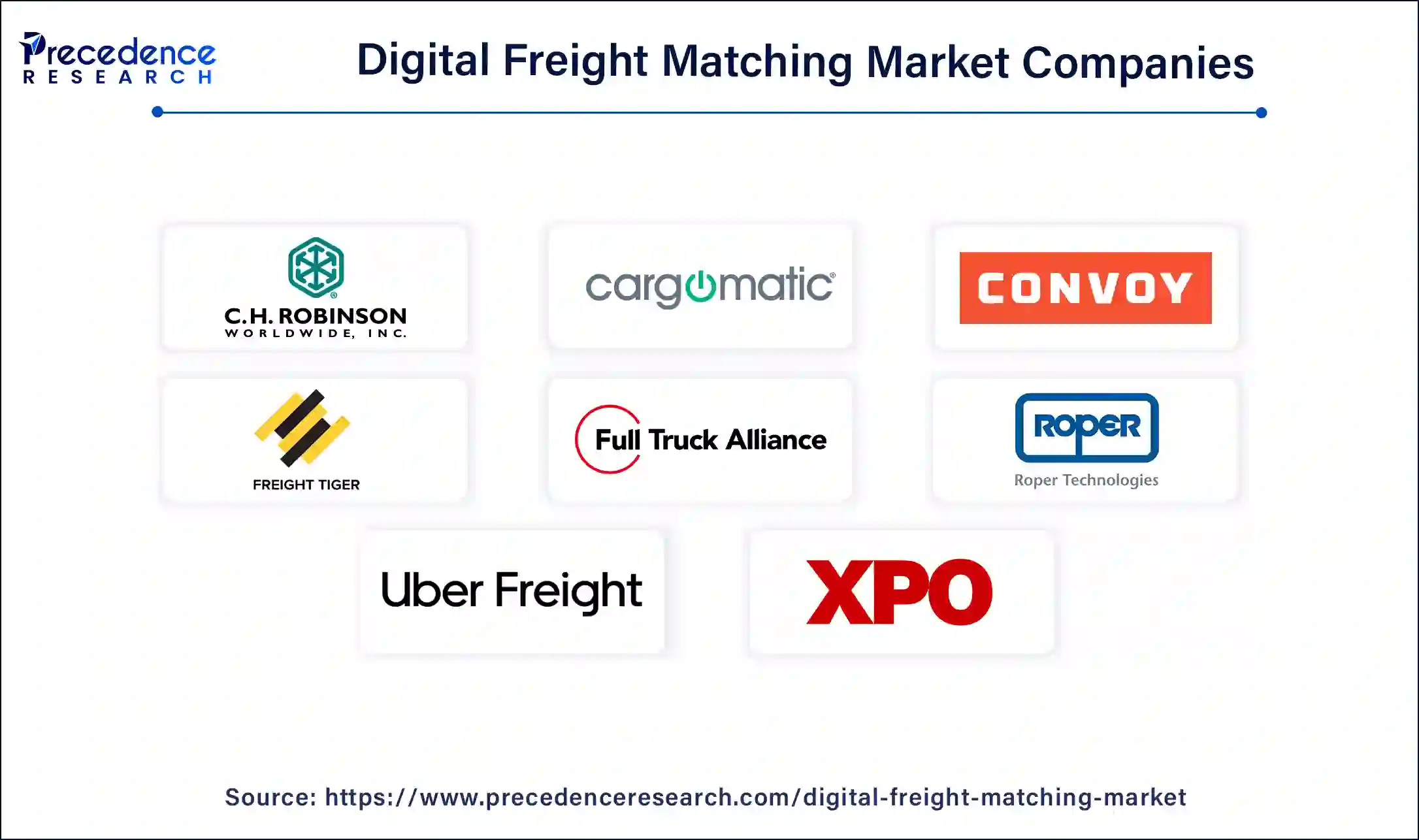
By Service
By Platform
By Transportation Mode
By Industry
By Geography
For inquiries regarding discounts, bulk purchases, or customization requests, please contact us at sales@precedenceresearch.com
No cookie-cutter, only authentic analysis – take the 1st step to become a Precedence Research client
March 2025
January 2025
August 2024
October 2024